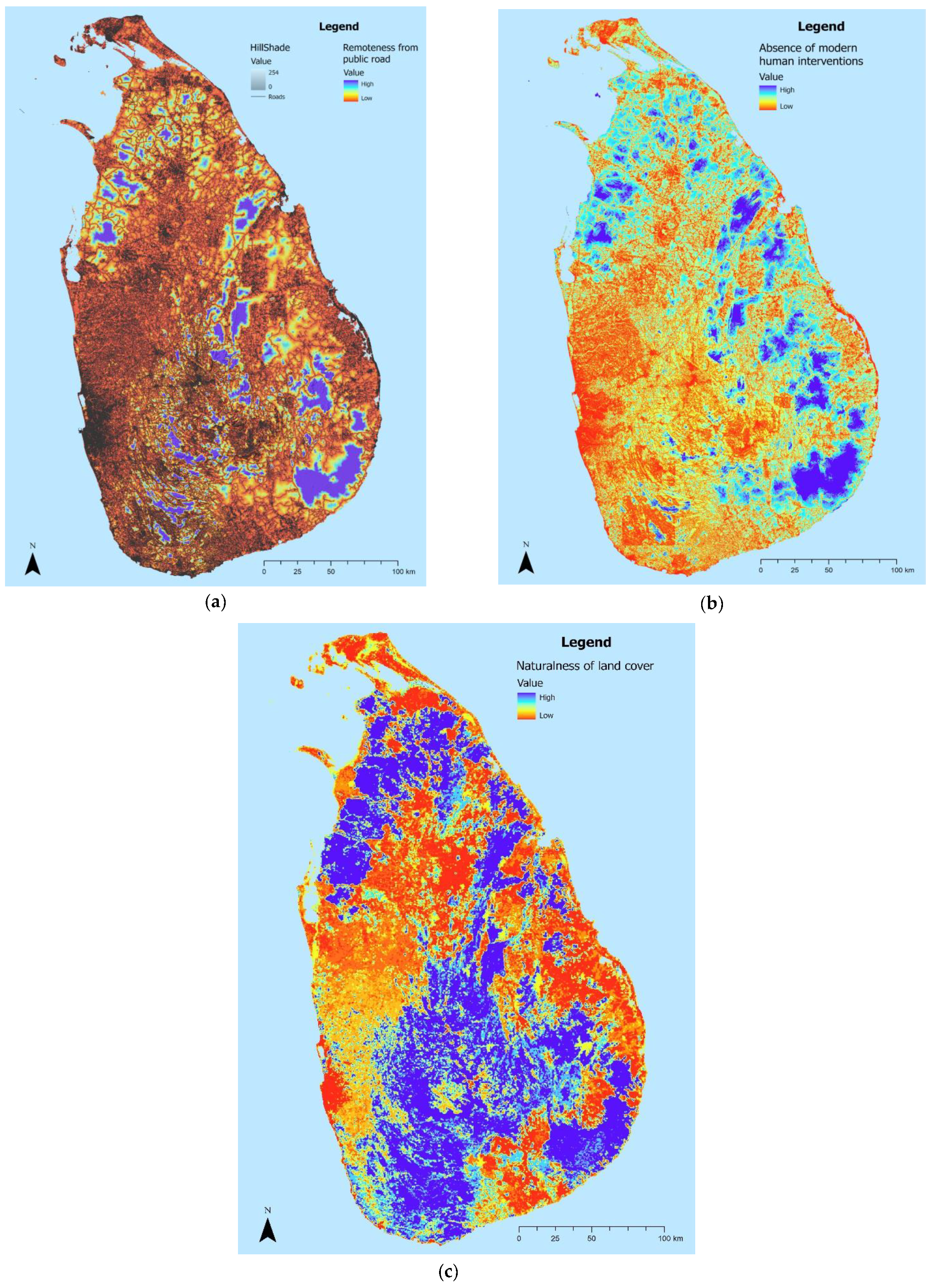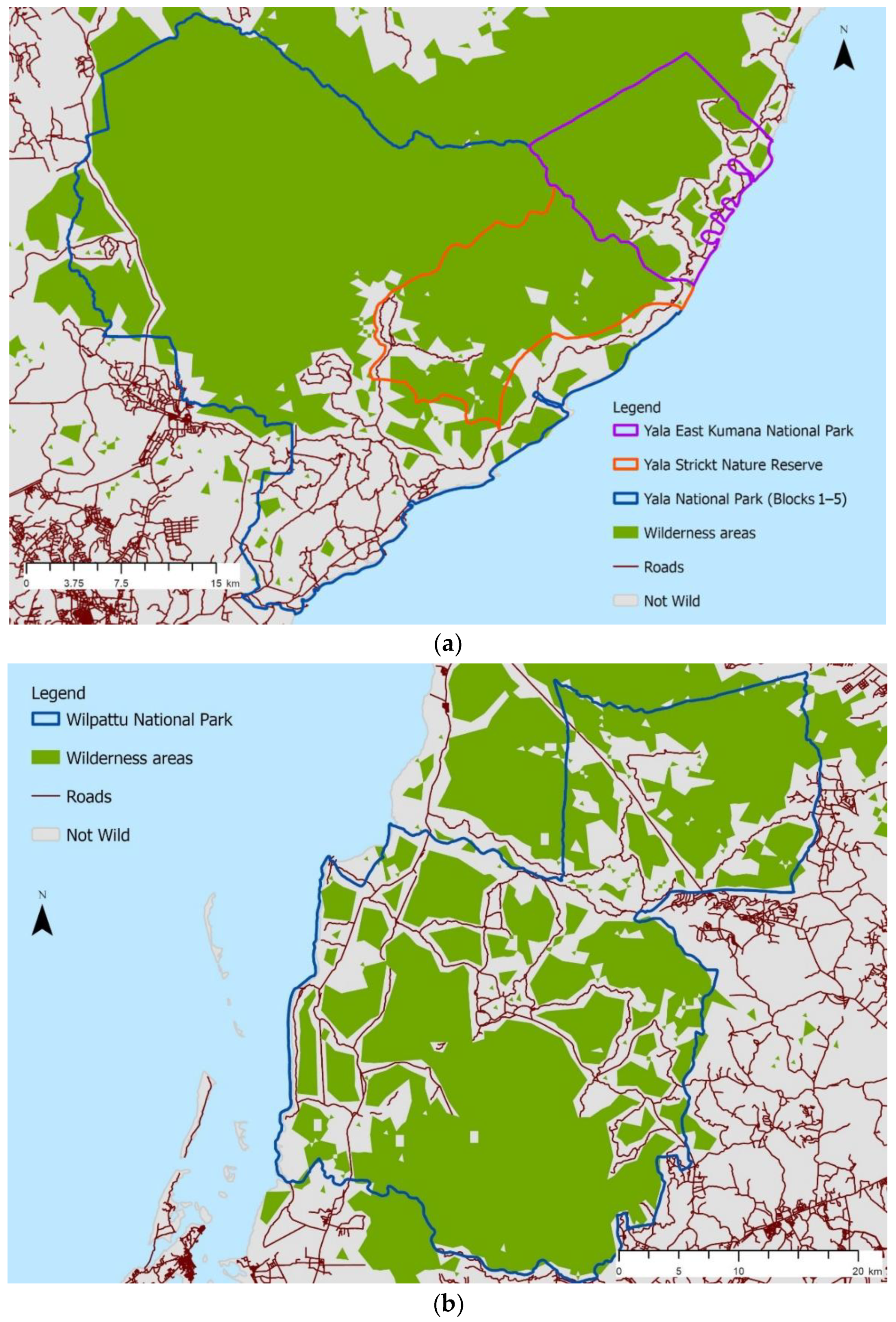Unveiling Sri Lanka’s Wilderness: GIS-Based Modelling of Wilderness Attributes
Abstract
1. Introduction
- construct a GIS-based spatial model that effectively captures the local perception and understanding of wilderness in Sri Lanka; and
- quantitatively assess the spatial extent and distribution patterns of wilderness quality in Sri Lanka; and
- conduct a comparative analysis of the wilderness map of Sri Lanka with existing protected area boundaries to identify and examine any disparities or variations.
2. Materials and Methods
2.1. Study Area
2.2. Method Development and Attribute Selection
2.3. Development of Principal Wilderness Attributes and Data Sources
2.3.1. Remoteness from Public Roads
2.3.2. Absence of Modern Human Interventions
2.3.3. Naturalness of Land Cover
2.4. Development of Wilderness Quality Index, Wilderness Zones, and Wilderness Patches
3. Results
3.1. Wilderness Attributes
3.1.1. Remoteness from Public Roads
3.1.2. Absence of Modern Human Interventions
3.1.3. Naturalness of Land Cover
3.2. Wilderness Quality Index (WQI) and Wilderness Zones
3.3. Wilderness Areas by Size
3.4. Wilderness Areas and Existing Protected Areas
3.4.1. Non-Protected (De Facto) Wilderness Areas
- Trincomalee and Kantale block;
- Moragahakanda;
- Nuwaragala Forest Reserve—South;
- Nelugala Jungle Corridor—North;
- Nelugala Jungle Corridor—South;
- Gal Oya National Park—West.
3.4.2. Wilderness Quality of Existing Protected Areas
4. Discussion
4.1. Comparing Research Outputs with Global-Scale Studies
4.2. Spatial Distribution of Wilderness Areas
4.3. Wilderness Areas and Protected Areas
4.4. Using Wilderness Quality Maps for Future Conservation Planning
4.5. WQI and Perception of Wilderness in Sri Lanka
4.6. Limitations
4.7. Recommendations
5. Conclusions
Author Contributions
Funding
Data Availability Statement
Acknowledgments
Conflicts of Interest
References
- Dudley, N. (Ed.) Guidelines for Applying Protected Area Management Categories; IUCN International Union for Conservation of Nature: Gland, Switzerland, 2008. [Google Scholar]
- Ward, K. For wilderness or wildness? Decolonising rewilding. In Rewilding; du Toit, J.T., Pettorelli, N., Durant, S.M., Eds.; Cambridge University Press: Cambridge, UK, 2019; pp. 34–54. [Google Scholar]
- Nash, R.F. Wilderness and the American Mind, 4th ed.; Yale University Press: New Haven, CT, USA, 1993. [Google Scholar]
- Carver, S.; Comber, A.; McMorran, R.; Nutter, S. A GIS model for mapping spatial patterns and distribution of wild land in Scotland. Landsc. Urban Plan. 2012, 104, 395–409. [Google Scholar] [CrossRef]
- Hawes, M.; Dixon, G. A remoteness-oriented approach to defining, protecting and restoring wilderness. PARKS 2020, 26, 23. [Google Scholar] [CrossRef]
- Watson, J.E.; Shanahan, D.F.; Di Marco, M.; Allan, J.; Laurance, W.F.; Sanderson, E.W.; Mackey, B.; Venter, O. Catastrophic declines in wilderness areas undermine global environment targets. Curr. Biol. 2016, 26, 2929–2934. [Google Scholar] [CrossRef] [PubMed]
- Convention on Biological Diversity. First Draft of the Post-2020 Global Biodiversity Framework-2017. Available online: https://www.cbd.int/doc/c/abb5/591f/2e46096d3f0330b08ce87a45/wg2020-03-03-en.pdf (accessed on 22 July 2023).
- Cao, Y.; Carver, S.; Yang, R. Mapping wilderness in China: Comparing and integrating Boolean and WLC approaches. Landsc. Urban Plan. 2019, 192, 103636. [Google Scholar] [CrossRef]
- Lesslie, R.G.; Maslen, M. National Wilderness Inventory: Handbook of Procedures, Content and Usage, 2nd ed.; Australian Government Publishing Service: Canberra, Australia, 1995. [Google Scholar]
- Lesslie, R.G.; Taylor, S.G. The wilderness continuum concept and its implications for Australian wilderness preservation policy. Biol. Conserv. 1985, 32, 309–333. [Google Scholar] [CrossRef]
- Radford, S.L.; Senn, J.; Kienast, F. Indicator-based assessment of wilderness quality in mountain landscapes. Ecol. Indic. 2019, 97, 438–446. [Google Scholar] [CrossRef]
- Carver, S.; Konráðsdóttir, S.; Guðmundsson, S.; Carver, B.; Kenyon, O. New Approaches to Modelling Wilderness Quality in Iceland. Land 2023, 12, 446. [Google Scholar] [CrossRef]
- Sanderson, E.W.; Jaiteh, M.; Levy, M.A.; Redford, K.H.; Wannebo, A.V.; Woolmer, G. The Human Footprint and the Last of the Wild: The human footprint is a global map of human influence on the land surface, which suggests that human beings are stewards of nature, whether we like it or not. BioScience 2002, 52, 891–904. [Google Scholar] [CrossRef]
- McCloskey, J.M.; Spalding, H. A reconnaissance-level inventory of the amount of wilderness remaining in the world. Ambio 1989, 18, 221–227. [Google Scholar]
- See, L.; Fritz, S.; Perger, C.; Schill, C.; Albrecht, F.; McCallum, I.; Schepaschenko, D.; Van der Velde, M.; Kraxner, F.; Baruah, U.D.; et al. Mapping human impact using crowdsourcing. In Mapping Wilderness; Springer: Dordrecht, The Netherlands, 2016; pp. 89–101. [Google Scholar]
- Sanderson, E.W.; Fisher, K.; Robinson, N.; Sampson, D.; Duncan, A.; Royte, L. The March of the Human Footprint. 2022. Available online: https://ecoevorxiv.org/repository/view/3641/ (accessed on 22 July 2023).
- Henry, D.; Husby, E. Wilderness quality mapping in the Euro-Arctic Barents region: A potential management tool. In Proceedings of the 1995 ESRI International User Conference: Creating a New World, Palm Springs, CA, USA, 22 May 1995; pp. 1–13. [Google Scholar]
- Ceaușu, S.; Hofmann, M.; Navarro, L.M.; Carver, S.; Verburg, P.H.; Pereira, H.M. Mapping opportunities and challenges for rewilding in Europe. Conserv. Biol. 2015, 29, 1017–1027. [Google Scholar] [CrossRef] [PubMed]
- Müller, A.; Bøcher, P.K.; Svenning, J.C. Where are the wilder parts of anthropogenic landscapes? A mapping case study for Denmark. Landsc. Urban Plan. 2015, 144, 90–102. [Google Scholar] [CrossRef]
- Măntoiu, D.Ş.; Nistorescu, M.C.; Şandric, I.C.; Mirea, I.C.; Hăgătiş, A.; Stanciu, E. Wilderness areas in Romania: A case study on the Southwestern Carpathians. In Mapping Wilderness: Concepts, Techniques and Applications; Springer: Berlin/Heidelberg, Germany, 2016; pp. 145–156. [Google Scholar]
- Ólafsdóttir, R.; Sæþórsdóttir, A.D.; Runnström, M. Purism scale approach for wilderness mapping in Iceland. In Mapping Wilderness; Springer: Dordrecht, The Netherlands, 2016; pp. 157–176. [Google Scholar]
- Plutzar, C.; Enzenhofer, K.; Hoser, F.; Zika, M.; Kohler, B. Is there something wild in Austria? In Mapping Wilderness; Springer: Dordrecht, The Netherlands, 2016; pp. 177–189. [Google Scholar]
- Convention on Biological Diversity-Country Profiles: Sri Lanka. Available online: https://www.cbd.int/countries/profile/?country=lk (accessed on 22 June 2023).
- Wildlife Conservation Society—Summary of Human Footprint Data for Sri Lanka, March of the Human Footprint Website. Available online: https://wcshumanfootprint.org/map/ (accessed on 20 December 2022).
- Ministry of Mahaweli Development and Environment. National Biodiversity Strategic Action Plan 2016–2022; Biodiversity Secretariat, Ministry of Mahaweli Development and Environment: Colombo, Sri Lanka, 2016. [Google Scholar]
- Survey Department of Sri Lanka. Available online: https://www.survey.gov.lk/sdweb/home.php (accessed on 27 July 2023).
- Conservation International. Biodiversity Hotspots. Available online: https://www.conservation.org/priorities/biodiversity-hotspots (accessed on 29 December 2023).
- Convention on Biological Diversity—National Biodiversity Strategic Action Plan: 2016–2022. Available online: https://www.cbd.int/doc/world/lk/lk-nbsap-v2-en.pdf (accessed on 10 January 2024).
- Gunatilleke, N.; Pethiyagoda, R.; Gunatilleke, S. Biodiversity of Sri Lanka. J. Natl. Sci. Found. Sri Lanka 2008, 36, 25–61. [Google Scholar] [CrossRef]
- The Parliament of Sri Lanka, The Government Publication Bureau. National Heritage Wilderness Areas Act, No. 3 of 1988; The Parliament of Sri Lanka, The Government Publication Bureau: Colombo, Sri Lanka, 1998. [Google Scholar]
- Fritz, S.; See, L.; Carver, S. A fuzzy modeling approach to wild land mapping in Scotland. In Innovations in GIS 7. GIS and Geocomputation; Atkinson, P.M., Martin, D., Eds.; CRC Press: Boca Raton, FL, USA, 2000. [Google Scholar]
- Carver, S.; Fritz, S. Mapping remote areas using GIS. In Landscape Character: Perspectives on Management and Change; Usher, M., Ed.; Natural Heritage of Scotland Series; HMSO: London, UK, 1999. [Google Scholar]
- Wild Europe. A Working Definition of European Wilderness and Wild Areas. 2013. Available online: https://www.europarc.org/wp-content/uploads/2015/05/a-working-definition-of-european-wilderness-and-wild-areas (accessed on 20 July 2023).
- The World Database on Protected Areas. Available online: https://www.protectedplanet.net/en/thematic-areas/wdpa?tab=WDPA (accessed on 27 July 2023).
- Department of Forest Conservation of Sri Lanka. Available online: https://www.mwfc.gov.lk (accessed on 20 June 2023).
- Department of Wildlife Conservation of Sri Lanka-Protected Areas. Available online: https://www.dwc.gov.lk/protected-areas/ (accessed on 24 July 2023).
- Selva, N.; Switalski, A.; Kreft, S.; Ibisch, P.L. Why keep areas road-free? The importance of roadless areas. In Handbook of Road Ecology; John Wiley & Sons, Ltd.: Hoboken, NJ, USA, 2015; pp. 16–26. [Google Scholar]
- Environmental Foundation-Deforestation—North of Wilpattu National Park: Site Visit Report. Available online: https://efl.lk/wp-content/uploads/2018/08/wilpattu-site-visit-report-final.pdf (accessed on 10 January 2024).







| Source | Data | Type | Resolution | Year | |
|---|---|---|---|---|---|
| Survey Department of Sri Lanka | Digital terrain model | Raster | 5 m | https://www.survey.gov.lk/sdweb/pages_more_feature.php?id=3de826c0fd66f54a700c6b497c14ae1c113d28ee&l=sd (accessed on 27 July 2023) | 2015 |
| Copernicus Climate Change Service | Land cover | Raster | 250 m | https://cds.climate.copernicus.eu/cdsapp#!/dataset/satellite-land-cover?tab=form (accessed on 26 July 2023) | 2018 |
| OpenStreetMap | Railways | Vector | - | https://download.geofabrik.de/asia/sri-lanka.html (accessed on 20 July 2023) | 2022 |
| OpenStreetMap | Roads | Vector | - | https://download.geofabrik.de/asia/sri-lanka.html (accessed on 20 July 2023) | 2022 |
| OpenStreetMap | Buildings and other built structures | Vector | - | https://download.geofabrik.de/asia/sri-lanka.html (accessed on 20 July 2023) | 2022 |
| World Database on Protected Areas (WDPA) | Protected areas | Vector | - | https://www.protectedplanet.net/ (accessed on 27 July 2023) | 2016 |
| No | Name of the Wilderness Area | Area (km2) | Altitude (m) |
|---|---|---|---|
| 1 | Padawiya Forest Reserve | 102 | 47–163 |
| 2 | Wilpattu National Park—North | 261 | 25–90 |
| 3 | Veppal Forest Reserve | 146 | 11–95 |
| 4 | Wilpattu National Park—South | 459 | 6–122 |
| 5 | Trincomalee and Kantale block | 470 | 11–235 |
| 6 | Hurulu Forest Reserve | 119 | 101–230 |
| 7 | Minneriya and Giritale Nature Reserve | 110 | 90–540 |
| 8 | Wasgamuwa National Park | 352 | 40–513 |
| 9 | Knuckles Conservation Forest | 156 | 109–1868 |
| 10 | Maduru Oya National Park | 125 | 86–653 |
| 11 | Nuwaragala Forest Reserve-South | 154 | 54–653 |
| 12 | Nelugala Jungle Corridor | 137 | 81–834 |
| 13 | Gal Oya National Park | 481 | 50–835 |
| 14 | Bakmitiyawa Thibirigolla Forest Reserve | 212 | 8–265 |
| 15 | Yala National Park | 1550 | 1–413 |
| 16 | Ilukpelessa and Bogahapelessa Forest Reserve | 141 | 141–739 |
| 17 | Peak Wilderness Nature Reserve | 120 | 574–2061 |
| 18 | Sinharaja National Heritage Wilderness Area | 176 | 40–1379 |
| Protected Areas Category | Wilderness Quality on a Scale of 1–256 (1 = Low, 256 = High) | Wilderness Quality | |
|---|---|---|---|
| Mean | Std. Dev | ||
| National Park | 3–256 | 129.5 | 72.9 |
| Nature Reserve | 5–235 | 116.1 | 64.7 |
| Strict Nature Reserve | 4–211 | 127.3 | 50.4 |
| Jungle Corridor | 7–193 | 102.4 | 49.4 |
| Sanctuary | 1–223 | 109.5 | 63.1 |
| Conservation Forest | 1–240 | 122.0 | 68.6 |
| Forest Reserve | 4–222 | 111.6 | 62.6 |
| National Heritage Wilderness Areas | 57–224 | 142.0 | 44.3 |
| Other State Forest | 3–238 | 117.0 | 61.2 |
Disclaimer/Publisher’s Note: The statements, opinions and data contained in all publications are solely those of the individual author(s) and contributor(s) and not of MDPI and/or the editor(s). MDPI and/or the editor(s) disclaim responsibility for any injury to people or property resulting from any ideas, methods, instructions or products referred to in the content. |
© 2024 by the authors. Licensee MDPI, Basel, Switzerland. This article is an open access article distributed under the terms and conditions of the Creative Commons Attribution (CC BY) license (https://creativecommons.org/licenses/by/4.0/).
Share and Cite
Mudalige, U.; Carver, S. Unveiling Sri Lanka’s Wilderness: GIS-Based Modelling of Wilderness Attributes. Land 2024, 13, 402. https://doi.org/10.3390/land13040402
Mudalige U, Carver S. Unveiling Sri Lanka’s Wilderness: GIS-Based Modelling of Wilderness Attributes. Land. 2024; 13(4):402. https://doi.org/10.3390/land13040402
Chicago/Turabian StyleMudalige, Uthpala, and Steve Carver. 2024. "Unveiling Sri Lanka’s Wilderness: GIS-Based Modelling of Wilderness Attributes" Land 13, no. 4: 402. https://doi.org/10.3390/land13040402
APA StyleMudalige, U., & Carver, S. (2024). Unveiling Sri Lanka’s Wilderness: GIS-Based Modelling of Wilderness Attributes. Land, 13(4), 402. https://doi.org/10.3390/land13040402







